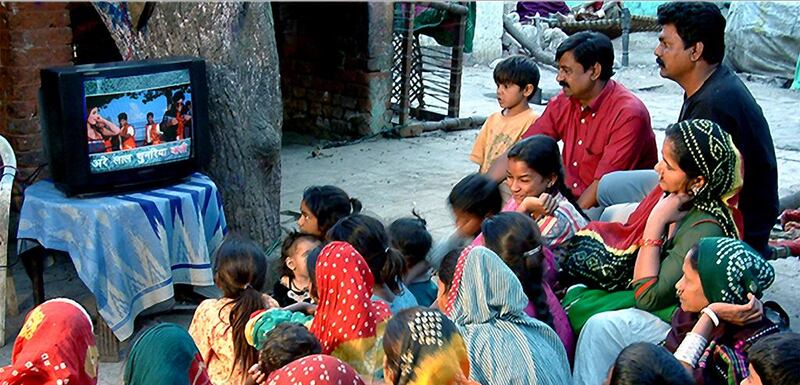Often criticised for its suggestive dance sequences and over-the-top melodrama, the Hindi film industry has emerged triumphant in the field of literacy. For millions of barely literate Indians, singing along to their favourite film songs while watching television has become a way to improve their reading skills.
The trick is in the subtitles. The project, Same Language Subtitling by the non-profit organisation PlanetRead, is based on a simple concept: by regularly watching films in which the songs are subtitled in the language they speak, millions of villagers and slum-dwellers with weak reading skills effectively get reading practice.
Over time, their reading improves, enabling them to read newspapers, fill out government forms and try for better jobs.
In September, in recognition of the Same Language Subtitling project’s effect on 200 million people, it won The International Prize as part of the Library of Congress Literacy Awards – its inaugural award for literacy.
Announcing the prize, the Library of Congress said: “It is simple to implement and easy to replicate, reaching 200 million low-literacy TV viewers. Same Language Subtitling is notable as a highly motivational approach for getting low-literacy adults to read, particularly where access to books is difficult.”
Independent studies have shown that three to five years’ exposure to Same Language Subtitling can enable a person who is familiar with the alphabet to become functionally literate.
Before exposure to subtitles, only 34 per cent of people surveyed could read a newspaper. After the exposure, 70 per cent could read a newspaper.
“It doesn’t make weak readers great readers in six months. But over time, it transforms millions of budding readers into functional readers,” said Brij Kothari, the academic who conceived the idea 17 years ago.
“Reading subtitles is automatic and inescapable. The key is for the word to match the audio. Neuroscience has proved that what fires together, wires together – so when the audio and words start firing together, the two fuse in the mind.”
Kothari, 49, is a professor at the Indian Institute of Management in Ahmedabad who spends half the year in India and the other half in Berkeley, California, where his family lives.
He realised that, with the simple addition of subtitles to Bollywood’s prolific output, barely literate Indians would instinctively and automatically read the lyrics of the songs they watched on television.
He persuaded the national broadcaster, Doordarshan, to put Hindi subtitles on Hindi films. Each word is highlighted as it is sung. The effect on viewers’ reading skills is, in Kothari’s analogy, akin to that of “anaemic people eating wheat fortified with iron – they benefit without being conscious of it”.
Chethna Ashish Bhatt, 24, a housewife in Ahmedabad, is surprised at her progress: “I used to struggle to read words on signposts and hoardings, but now it’s much easier. And I read a newspaper once a week,” she said.
The idea for the programme first occurred to Kothari when he was trying to learn Spanish by watching Spanish films. If the subtitles had been in Spanish rather than in English, he used to think, his Spanish would improve.
He told friends that if Hindi movies has subtitles in Hindi, India would become literate. Everyone said it was too simple. Had it been so easy and effective, someone would have already thought of it, surely? But no one had.
Officially, 73 per cent of India’s 1.2 billion people are literate, according to data from 2011. But the figure is misleading, in that, for half of them, “literate” is a misnomer because they cannot read a newspaper headline.
All “literate” means is that they can sign their name. Studies show that a large percentage cannot even do that, or can only partially sign their name. It is these weak readers that Kothari targets through subtitles.
Currently, the subtitles are in three languages. Kothari’s goal is to ramp it up by persuading the government to have a broadcasting policy, which puts subtitles on all songs on television, in all 22 official languages. That way, he will be able to reach out to about 700 million viewers.
Meanwhile, word of the project is spreading. A member of his team has left for Kabul to explain the concept to the Afghan government.
“In a country where girls and women are prevented from going out, improving their literacy through watching television at home is appealing – even the Taliban can’t stop that,” said Kothari.
As part of the project, Kothari’s team has studied the first words that register in the minds of viewers. Given the romantic content of Bollywood songs, it should come as no surprise that they are pyar (love), surat (face) and sapna (dream).
artslife@thenational.ae
Follow us @LifeNationalUAE
Follow us on Facebook for discussions, entertainment, reviews, wellness and news.





